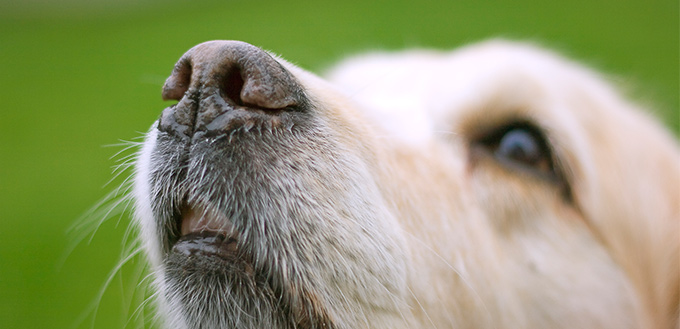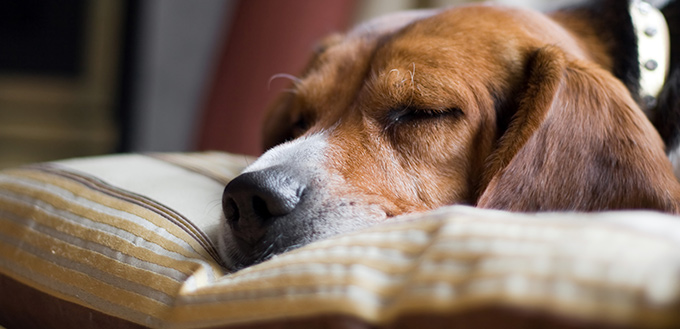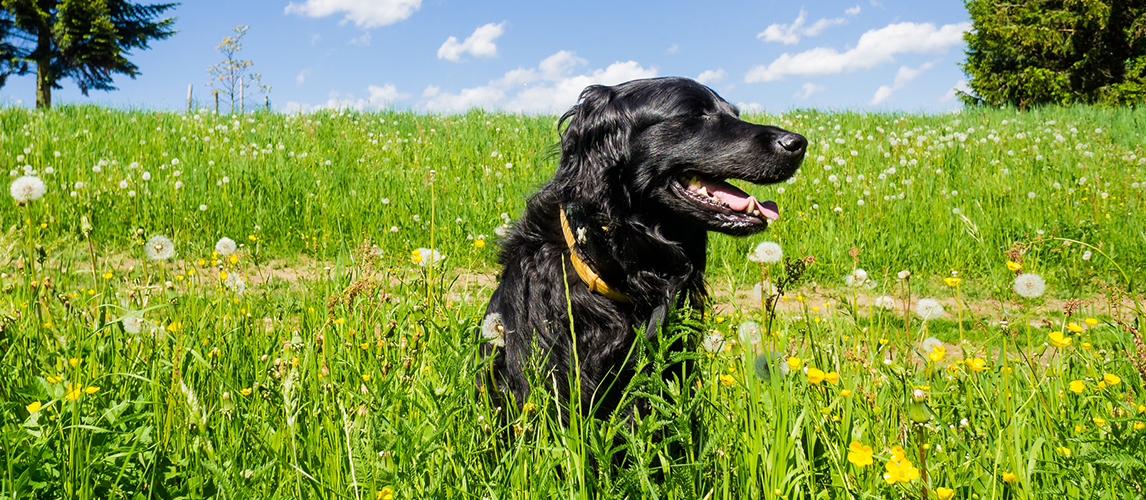We all know dogs are excellent smellers, but their noses can do more than sniff our faces and pockets.
Have you ever experienced the enthusiasm of a curious dog’s nose? Probably a new dog once investigated your hands and decided you were his friend immediately. Or maybe your dog jams up his cold nose on your face every morning. Our dog’s noses do lots of fantastic stuff when they want to communicate something to us or understand the world. Here are some fun facts about dog’s senses of smell and how their noses work.
1. Dogs Tell Time with The Scent
Do you ever wonder how your pet knows it’s time for you to leave work? How come you always find him at the door waiting for you? Although it’s partly because of your routine, dogs can tell the time through their sense of smell.
Have you ever realized that you can tell when it’s afternoon simply by the way your home looks (the deepening light)? Just like how light passes through our windows to alert us of the time, so do smells. Smells move with air currents into our homes, and our dogs capture these smells. When the scent in your home changes at a particular time of the day, your dog can tell that something is about to happen; like you coming from work. Nice one, right? So, next time your dog comes to you with her leash, you may want to listen – the chances are that it’s time to leave.
You May Also Like: Dog Leashes

2. Dogs Can Pick Up Invisible Things
Have you ever heard that dogs could sniff out cancer? Well, they can. Dogs can tell when their own are pregnant. All this is because of the dog’s incredible sense of smell. Your dog has a secondary receptor in his nose known as vomeronasal organ. This receptor is responsible for sniffing things that aren’t visible to the human eye. The organ can sense hormones and pheromones, things that enable dogs to tell a lot of stuff.
Dogs can tell when another dog is friendly or hostile through the receptor. That is why dogs like smelling specific areas within the neighborhood. If you have seen them doing this, you might wonder why they do this. When your dog smells these spots, he will know everything about other dogs that have been in the neighborhood. They can tell whether the dogs within that area are healthy, unwell or even stressed out. Also, you can never fool your pet when you are stressed; they can smell the hormone on you that are produced when feeling particular emotions.
3. The Length of A Dog’s Nose Matters
Do you know that dogs which have longer snouts have stronger senses of smell than those with shorter muzzles? For instance, a German shepherd has over 300 million smell receptors inside its nose. That is why the breed is used in drug tracking and detection. On the other hand, a Chihuahua has a shorter nose, meaning that it has few scent receptors in his nose because there isn’t sufficient room in their small muzzles for many cells.
That is why only a few selected breeds can be used as service and rescue dogs. You might also have noticed that smaller dogs like the Maltese and the Pekinese have much rounder eyes that the large breeds. This is because they depend on their sense of sight more than their sense of smell because they have few receptors.
4. A Dry Nose Is Not A Sign Of Illness
It’s a common belief that when dogs have a dry, hot nose, they are unwell. This might be true, but not always. A dry nose is not an automatic indication that a dog is sick. The moisture on the dog’s nose depends on the environment, the weather and the time of day. Sick dogs could also have a wet nose.
Dogs have wet noses for various reasons. One of them is that they clean their noses often to get rid of food or dust that could be blocking their capacity to smell other things. Another reason is that the mucous that dogs secrete helps in picking scents better. Also, their noses get wt when during hot days since it helps them cool down.
5. There Is A Distinction Between Tracking And Trailing
When you imagine how fantastic a dog’s nose is, you immediately visualize a dog’s snout sniffing the ground, or following a scent to find a missing item or person. You have probably seen how the service dogs are given a piece of cloth to smell and then they immediately start following a scent trail to find the person who wore the clothing. What you have in mind is known as trailing. This is when a dog follows a particular smell. During trailing, the dog follows an existing scent trail.
Another nose-based trick that dogs do is known as tracking, which is different from trailing. Tracking dogs don’t follow the scent after being introduced to it through a piece of clothing. On the contrary, they look for a fresh track, which includes both visual cues and smell. It is just like hunting. For instance, a dog that has been trained to track narcotics will merely look for the evidence of the drug when prompted to. Once they are sure of the presence of the narcotic, they follow the tracks. A dog that uses logic in addition to scent information is likely to locate the animal, person or substance easily.

6. A Dog’s Nose Print Is Just Like A Fingerprint
Did you know that just like fingerprints, a dog’s nose is exceptionally shaped? Every single dog all over the universe has an exclusive nose print. Some companies have started registering nose prints so that they can find your dog if he gets lost. Some kennel manufacturing companies use this aspect to offer additional security for dogs.
If you are a fan of art, here’s a cool idea of a project you can do. Buy a food-grade coloring and apply on your dog’s nose, and then press it on cardboard or paper, which you can then frame. If you own many dogs, your piece of art will even look better because of the assortment of nose prints. As long as the color is food-grade, your dog can lick it all she wants. If you can do advanced art, you may turn the print into a pendant or a metal necklace and use it to gift your friends and family.
7. Some Dogs Use Their Ears To Smell
Remember the point on the significance of nose lengths? Most dogs that have shorter noses have to compensate their sense of smell through other organs like the ears and eyes. The ears play a critical role in detecting scents for some dogs, such as the classic hound and the basset hound. These breeds have long, droopy ears that drag the ground.
The ability to use ears for smelling is a desirable trait when selecting a hunting dog. The ears pick the aroma from the ground, and up the nose in more excellent detail; thus enabling the nose to collect more information. Isn’t this cool? Just ensure that you clean your dog’s ears because dragging them on the ground can make a lot of dirt to enter the ear folds, which might cause an infection.
You May Also Like: Dog Ear Cleaners
How Does A Dog’s Nose Work?
Firstly, dogs smell scents more than once. Have you ever realized that dogs have slits on the outer part of their nostrils? This is where they exhale. Therefore, they inhale via the nostrils and exhale through the slits. That means there is a kind of circulation of the scent molecules. They smell scents as they inhale and feel them again as they exhale.
Secondly, their nostrils work separately. Every nostril smells something different all the time, and a dog can understand both sensory inputs concurrently. This implies that dogs do not just tell what the smell is, but they can trace where it is coming from.
Should You Allow Your Dog to Smell Their Way Around?
While the first thing that humans do when they meet is to have a chit chat, dogs like going for the “good” information directly. Unfortunately, this is not always a good thing for dog owners. The human groin, mouth, shoes and the armpits are the best places to get information about an individual. These are the places where we have the most scent because of how our biology works. As a dog owner, you might feel a little embarrassed when you visit a friend, and your dog starts smelling your friend in these areas.
When a dog starts smelling your armpits or those of a friend, try distracting the dog. Just give him a new scent, such as your sweater or food. He will leave your armpits and go for the fresh scent. Avoid pulling your dog away from good smells that they seem eager to check out such as flowers; you might make them lose their ability to smell. Encourage and allow your pet to continue smelling so that they maintain sharp senses of smell.
Sources:
- Dr. Jennifer Coates, 8 Dog Nose Facts You Probably Didn’t Know, PetMD
- Mallory T. DeChant, M.S., When the Nose Doesn’t Know: Canine Olfactory Function Associated With Health, Management, and Potential Links to Microbiota, Frontiers






